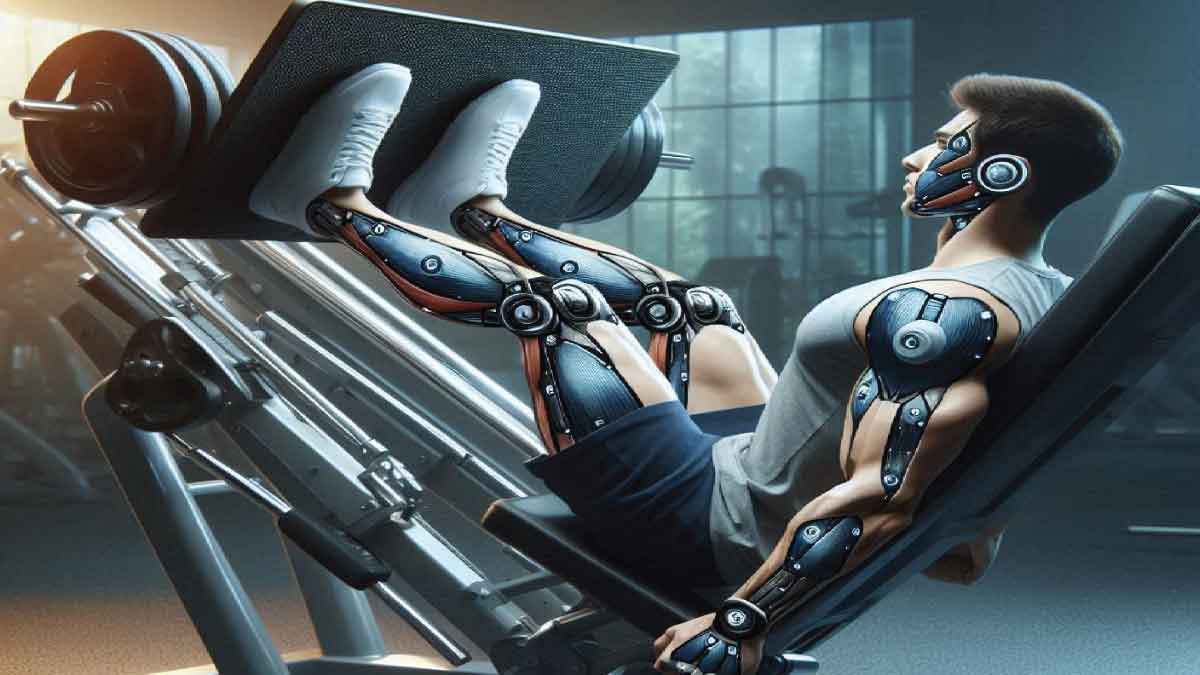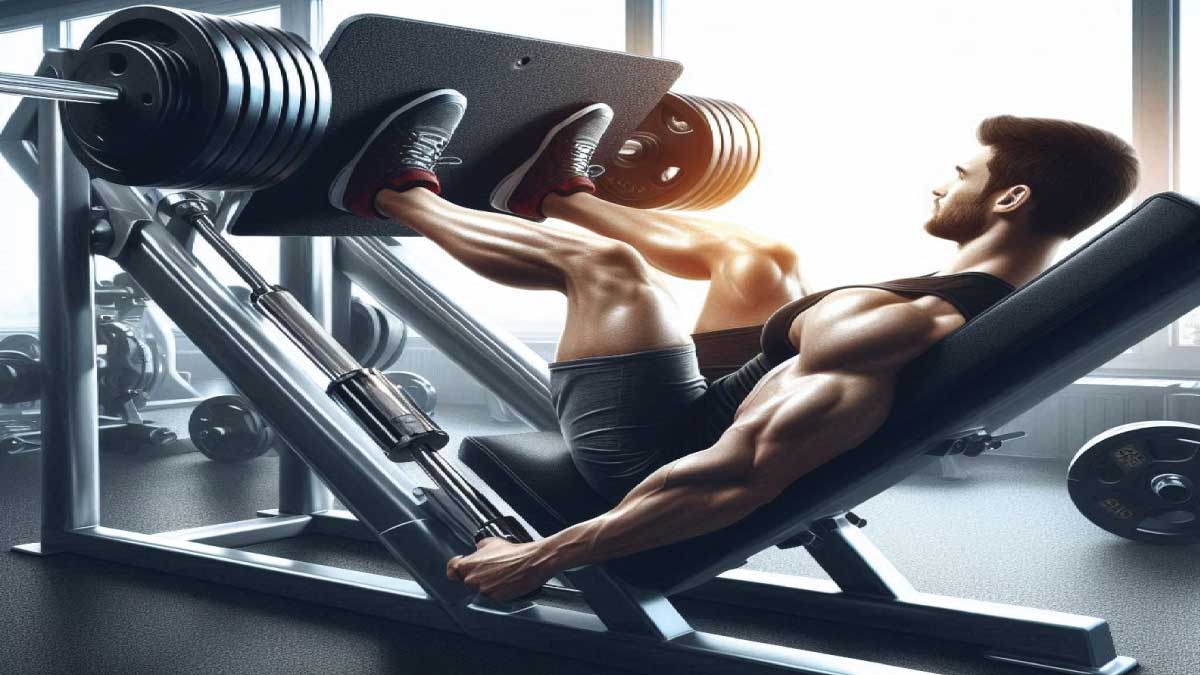Benefits of Leg Press Exercises

1. Muscle Development
The leg press exercise stands as a stalwart in the realm of strength training, honing in on the quadriceps, hamstrings, and glutes with precision. Through targeted resistance, this compound movement ignites muscle fibres, fostering growth and fortitude in these key areas. Unlike isolated exercises, the leg press engages multiple muscle groups simultaneously, amplifying the efficacy of each repetition. This synergistic approach not only expedites muscle development but also cultivates overall strength, enabling individuals to push their physical limits with each session.
2. Joint Support
One of the leg press’s inherent advantages lies in its ability to provide robust joint support during workouts. Unlike traditional free weight exercises, where the burden of resistance rests solely on the user’s joints, the leg press machine distributes weight evenly, alleviating undue stress. This equitable distribution reduces the risk of strain or injury, making it an ideal option for individuals with pre-existing joint conditions or those on the path to recovery. By fostering a supportive environment, the leg press empowers users to train with confidence, knowing that their joints are safeguarded against potential harm.
3. Functional Strength
Beyond the realm of muscle development, the leg press exercise transcends into the domain of functional strength, bridging the gap between gym performance and real world functionality. By replicating common movements such as squatting and lifting, this dynamic exercise cultivates strength that directly translates into daily activities and athletic endeavours. Whether it’s lifting groceries, climbing stairs, or excelling on the sports field, individuals who integrate the leg press into their fitness regimen emerge with heightened functional capabilities, enhancing their quality of life in the process.
4. Improved Bone Density
Regular participation in weight-bearing exercises, such as the leg press, has been linked to improvements in bone density. As individuals push against resistance during leg press workouts, the mechanical stress applied to bones stimulates the production of new bone tissue, thereby enhancing overall bone strength and reducing the risk of osteoporosis. This is particularly beneficial for individuals at risk of age-related bone loss or those seeking to mitigate the effects of sedentary lifestyles. By incorporating the leg press into their fitness routine, individuals can promote skeletal health and longevity.
5. Enhanced Metabolic Rate
The leg press exercise, with its emphasis on large muscle groups, contributes to an elevated metabolic rate both during and after workouts. The high energy expenditure associated with leg press sessions not only burns calories effectively but also promotes the development of lean muscle mass. As lean muscle tissue requires more energy to maintain than fat tissue, individuals who engage in regular leg press workouts may experience a sustained increase in metabolic rate, even at rest. This metabolic boost can aid in weight management efforts and contribute to overall metabolic health, making the leg press a valuable asset in achieving fitness goals.
6. Improved Posture and Stability
Proper form is paramount in performing the leg press, necessitating core engagement and alignment throughout the movement. By reinforcing correct posture and alignment, the leg press exercise helps individuals develop greater stability and balance, both inside and outside the gym. Strengthening the muscles surrounding the spine and pelvis promotes spinal alignment and reduces the risk of postural imbalances and associated injuries. As individuals cultivate a stronger foundation through leg press training, they can carry themselves with confidence and grace in their daily activities, fostering long-term musculoskeletal health and well-being.
In a result, the leg press exercise emerges as a cornerstone in the realm of strength training, offering a multitude of benefits for individuals seeking to enhance their physical prowess. From muscle development and joint support to functional strength, improved bone density, enhanced metabolic rate, and posture stability, this dynamic exercise transcends traditional boundaries, empowering users to unlock their full potential. By incorporating the leg press into their fitness regimen, individuals can embark on a transformative journey towards greater strength, resilience, and vitality.
Proper Technique for Maximum Results
Achieving optimal results from the leg press exercise demands meticulous attention to proper form and technique. Follow these comprehensive guidelines to ensure safe, effective, and rewarding workouts:
1. Seat Adjustment
Initiate your leg press session by meticulously adjusting the seat position to align with your body’s proportions. Ensure that your back rests firmly against the backrest, promoting stability and comfort throughout the exercise. Position your feet shoulder-width apart on the footplate, with your toes pointing slightly outward. This stance fosters balance and engages the muscles of the lower body optimally, laying the foundation for a successful workout.
2. Engage Core Muscles
Before initiating the movement, consciously engage your core muscles to stabilise your torso and maintain proper alignment. This proactive engagement not only fortifies your midsection but also mitigates the risk of lower back strain or injury. By activating the core, you create a solid foundation from which to execute each repetition with precision and control, maximising the efficacy of the exercise.
3. Controlled Movements
As you commence the leg press movement, prioritise controlled and deliberate motions to optimise muscle engagement and minimise the risk of injury. Slowly lower the platform by bending your knees, ensuring that your back remains flat against the seat throughout the descent. Aim to achieve a 90-degree angle at the knees, allowing for a full range of motion while maintaining proper biomechanics. Emphasise the eccentric phase of the movement, resisting the weight with controlled strength to maximise muscle activation.
4. Full Range of Motion
Harness the power of your lower body as you ascend from the lowered position, driving through your heels to extend your legs and push the platform away from your body. Focus on maintaining a fluid and continuous motion, avoiding any jerky or abrupt movements that could compromise form or stability. Strive to fully straighten your legs without locking your knees at the top of the movement, optimising muscle contraction and minimising stress on the joints. Embrace the challenge of each repetition, mindful of maintaining proper alignment and control throughout the entire range of motion.
5. Breathing
Integrate mindful breathing techniques into your leg press routine to enhance performance and promote optimal oxygenation of the muscles. Exhale forcefully as you exert effort to push the weight away from your body, engaging the muscles of the abdomen to facilitate a powerful contraction. Inhale deeply as you return to the starting position, allowing for a steady influx of oxygen to replenish and nourish your working muscles. Maintain a rhythmic breathing pattern throughout the exercise, synchronising your breath with the cadence of your movements to enhance endurance and sustain energy levels.
By adhering to these meticulous guidelines, you can unlock the full potential of the leg press exercise, maximising muscle engagement, strength gains, and overall performance. Prioritise proper form and technique with each repetition, and embrace the transformative power of this dynamic lower body workout.
Leg Press Workout Tips

Integrating the leg press exercise into your regular workout regimen can yield significant benefits for overall strength, muscle development, and functional fitness. To optimise the effectiveness of this dynamic lower body workout, consider the following tips for seamlessly incorporating the leg press into your exercise routine:
1. Progressive Overload
As with any resistance training programme, progressive overload is key to stimulating muscle growth and strength gains over time. Begin by selecting a challenging yet manageable weight for your leg press workouts, focusing on maintaining proper form and technique throughout each set. Gradually increase the resistance as your strength improves, aiming to progressively overload the muscles to encourage continual adaptation and growth.
2. Variation in Foot Position
To target different muscle groups within the lower body, experiment with various foot positions and stances during your leg press workouts. Utilise a narrow stance to emphasise the quadriceps, a wider stance to engage the glutes and hamstrings, and a neutral stance to promote overall balance and stability. By incorporating diverse foot placements into your routine, you can effectively target and develop all major muscle groups of the lower body, fostering balanced muscular development and functional strength.
3. Superset with Compound Movements
To maximise efficiency and intensity during your workouts, consider incorporating the leg press into supersets with other compound movements targeting complementary muscle groups. Pairing the leg press with exercises such as lunges, deadlifts, or calf raises can enhance muscular endurance, cardiovascular conditioning, and calorie expenditure, elevating the overall effectiveness of your training session. By strategically integrating supersets into your workout routine, you can optimise time efficiency while maximising the metabolic demands placed on the body, facilitating greater gains in strength, endurance, and muscle tone.
4. Utilise Tempo Training Techniques
Incorporating tempo training techniques into your leg press workouts can add a new dimension of challenge and stimulation to your routine. Experiment with varying the speed of each repetition, focusing on controlled eccentrics (lowering phase) and explosive concentrics (lifting phase) to optimise muscle recruitment and metabolic stress. By manipulating the tempo of your leg press movements, you can elicit greater muscle fibre activation, stimulate hypertrophy, and enhance overall muscular endurance, promoting continuous progress and adaptation over time.
5. Listen to Your Body
Above all, listen to your body and honour its signals throughout your leg press workouts. Pay attention to any signs of discomfort, fatigue, or overexertion, and adjust your training intensity and volume accordingly. Incorporate adequate rest periods between sets and workouts to promote recovery and prevent overtraining, allowing your muscles to repair and grow stronger. Prioritise proper nutrition, hydration, and sleep to support optimal performance and recovery, fuelling your body with the nutrients it needs to thrive and adapt to the demands of your training regimen.
By incorporating these strategic tips into your leg press workouts, you can maximise the effectiveness and efficiency of your training routine, unlocking new levels of strength, muscle development, and overall fitness. Approach each workout with intention, focus, and determination, and reap the rewards of your hard work and dedication in the form of tangible progress and results.
Conclusion
Incorporating the leg press exercise into your workout routine presents a myriad of advantages for those striving to bolster lower body strength and muscle growth. By adhering to proper technique and integrating this dynamic movement into your fitness regimen consistently, you can harness its full potential and expedite progress towards your fitness aspirations. Whether your goals encompass increased muscle tone, improved functional strength, or enhanced athletic performance, the leg press stands as a valuable tool in your arsenal. Embrace the challenge, stay committed to your fitness journey, and reap the rewards of your dedication as you embark on the path to greater strength, vitality, and overall well-being.
FAQs about Leg Press Exercises:
What muscles does the leg press work?
The leg press primarily targets the quadriceps, hamstrings, and glutes. However, it also engages secondary muscles such as the calves and lower back to a lesser extent.
Is the leg press machine suitable for beginners?
Yes, the leg press machine is beginner-friendly as it provides added support to the back and joints compared to free weight exercises. Beginners can adjust the weight settings and foot placement to suit their fitness level.
How many sets and reps should I do on the leg press?
The number of sets and reps on the leg press can vary depending on your fitness goals. However, a general guideline is to aim for 3-4 sets of 8-12 reps, adjusting the weight to challenge your muscles while maintaining proper form.
Can the leg press help with increasing vertical jump height?
Yes, incorporating leg press exercises into your training routine can improve lower body strength and power, which are essential for explosive movements like jumping. However, it should be complemented with other plyometric and strength exercises for optimal results.
Are there any variations of the leg press exercise?
Yes, there are several variations of the leg press, including the narrow stance leg press, wide stance leg press, and single-leg press. Each variation targets different muscle groups and provides unique challenges to keep your workouts diverse and effective.

